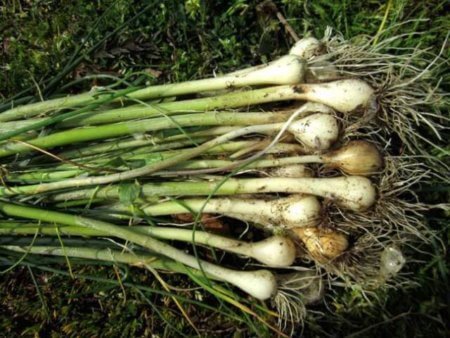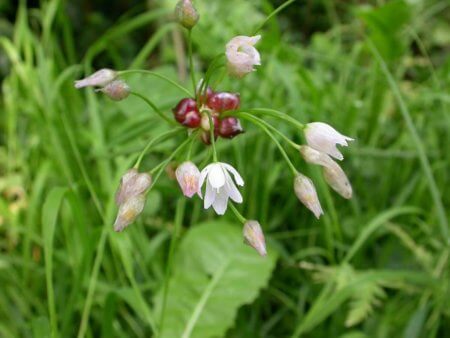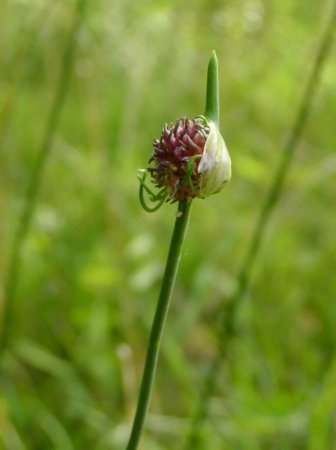Field Garlic
We’re all familiar with garlic, but what about field garlic? (Some call it wild garlic, crow garlic or stag’s garlic.) This is a bulbous plant that grows mostly in Europe, but also in some parts of the United States.
The aroma of field garlic makes it easy to identify in the wild, it has a strong odor that resembles onions. In fact, many people mistake this plant for wild onion.
What is field garlic? Field Garlic, also known as Allium vineale and Allium oleraceum. It has a smell that resembles onions and all parts of the plant are edible. Wild garlic is antibacterial and antifungal, making it good for things like yeast infections or urinary tract infections. It’s also a natural insect repellent.
That being said, field garlic looks convincingly similar to the poisonous Star of Bethlehem, so it’s crucial to identify this plant properly before deciding to eat it.
[wc_toggle title=“Table of Contents” padding=“” border_width=“” class=“” layout=“box”]
[/wc_toggle]
A Look at Field Garlic
When looking for field garlic, follow your nose! In addition, look for leaves that are clumped together and resemble grass. They typically grow to be about one to three feet tall and upon closer inspection, you’ll see that they’re hollow.

How can you find Field Garlic in nature?
The plant looks similar to chives. If you dig up the plant, you’ll see that its white bulbs sit beneath the soil. If you spot field garlic during the warmer months, it may be blooming purple bulbous flowers.
The most important thing to keep in mind is that the onion smell needs to be there for it to be field garlic! The toxic look-alikes don’t smell like onions.
In the mid-west and the north-east U.S. field garlic can be found in gardens, lawns, wooded areas and pretty much any area that can support grasses or plants. In some places, it seems like it’s everywhere!
Field garlic is super hardy and grows most of the year. One of the easiest times to find it is during the late fall and early spring when there isn’t a lot of snow on the ground but other plants aren’t around to disguise it.
Planting and Harvesting Field Garlic
If you want to grow your own wild garlic, pick up some seeds from a nursery, and if you can’t find any there, try looking online. You should sow the seeds in the springtime, and once they start to sprout, you can transfer them to individual pots.
With this plant, you can pot two or three of them together in the same pot. For best results, you should try to keep them in a greenhouse or similar area during their first winter season. This will build up their sturdiness and help them develop into stronger, more durable plants.
After that, you can plant them back outside once spring rolls around. By this point, the wild garlic should be a large and strong grower. Towards the end of the summer, you can harvest the garlic and use it as you like.

How to Prepare Field Garlic
Fortunately, the preparation for field garlic is straightforward and doesn’t take much time at all. Once you dig up the plant, wash it thoroughly, getting rid of any clinging dirt from the bulbs. Be careful with the leaves as you wash them, too. Peel away the topmost layer just as you would do with store-bought heads of garlic.
Can you eat Field Garlic?
At this point, you’re ready to chop up the bulbs and leaves for use in any number of recipes.
A quick note about using field garlic in different dishes. The bulb heads will have the most garlicky taste, while the leaves as a great substitute if you don’t have chives on hand.
You can garnish tons of dishes with the leaves or cook the chopped bulbs in some olive oil for an infused garlic oil.
The bulbs can be eaten raw or cooked according to your preference and the specific dish you want to create. For instance, try adding the bulbs to a homemade broth or soup or some extra flavor. As for the leaves, you can nibble on them right after washing them, or saute them and add them to stews and other cooked dishes.
It has to be noted that field garlic has an aftertaste that some people find offensive.

Field Garlic’s Medicinal Uses
Wild garlic has many of the same medicinal and health benefits as its regular, store-bought counterpart. For example, they can both contribute to lower cholesterol levels and arteriosclerosis, or the hardening and thickening of the arteries.
Wild garlic can be used to help lower blood pressure, and since it can easily be incorporated into so many recipes, it’s a useful herb to have on hand.
Field garlic, in particular, is antibacterial and antifungal, making it great for things such as yeast infections or urinary tract infections. It can also help to balance out your gut bacteria, much like yogurt.
Another cool tidbit about wild garlic is that it’s a natural digestive aid, helping to reset the system and keep things regular. It has a similar effect on the circulatory system, too.
Although not a medicinal use, wild garlic is a natural repellent for moths and many other insects, reducing the need for gardeners to use harmful pesticides. There aren’t any known negative side effects to using or consuming field garlic, as long as it’s properly identified and thoroughly washed prior to use.
Side Effects of Field Garlic
While there aren’t really any kind of side effects for humans associated with field garlic, it is considered a weed where it grows in North America.
It can give a garlic-like flavor to dairy and beef products where it grows in fields that livestock graze. It can also taint grain products when it grows near them giving them a garlic smell. Even when it’s sprayed with herbicides, it tends to be resistant to the effects. The vertical, waxy leaves tend to keep the herbicides from sticking.
If you decide to try to plant field garlic anywhere around your home or homestead, be aware that it’s going to spread! It doesn’t produce seeds very often but it does spread through side bulbs and the growth of runners. This is how it became so prolific and is considered an invasive weed.
Conclusion
Field garlic is an easy to find plant that can be used to give food an oniony garlic flavor. It’s hardy and can grow pretty much anywhere that grasses and other plants grow.
It does spread quickly and is considered an invasive species in some parts. It doesn’t have many side effects but it does contaminate the flavor of beef and dairy where the animals come in contact with them.
Field Garlic – How to Find it and How to Use it was first published on: www.readylifestyle-staging.gtgrgq9c-liquidwebsites.com
Field Garlic – How to Find it and How to Use it published first on https://readylifesytle.tumblr.com
Comments
Post a Comment